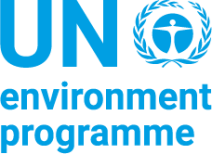GPSC Events
GPSC Webinar Series. Bringing Nature to Cities: Biophilic City Planning and Design - Integrating Nature as an Essential Element of Urban Futures
06 October 2021
,
10:00 am
/
Online
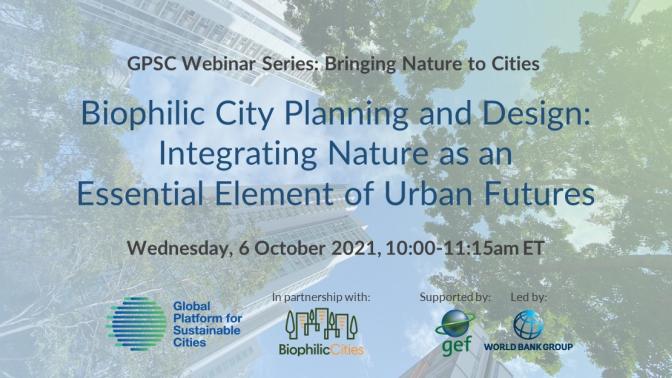
The World Bank’s webinar series “Bringing Nature to Cities: Integrated Urban Solutions to Biodiversity Loss and Climate Change” will promote integrated urban solutions for cities to tackle biodiversity loss and climate change. Co-hosted by the Global Platform for Sustainable Cities (GPSC) and the Global Program on Nature-Based Solutions for Climate Resilience, the series of thematic events will provide an online knowledge exchange platform connecting policymakers, practitioners, and experts to further mainstream biodiversity considerations into cities and development projects.
Biophilic city planning and design provides multifaceted solutions to primary challenges faced by cities, including climate change resilience, biodiversity loss, and equitable health and wellbeing. By intentionally integrating nature as an aspect of daily urban life, biophilic cities can sustainably and cost-efficiently create nature-rich landscapes where people thrive. This session will introduce the concepts of biophilic city planning and design while providing examples of their successful implementation throughout global cities participating in the Biophilic Cities Network.
Welcome and Introduction
JD Brown, Biophilic Cities Program Director, School of Architecture, University of Virginia
Panel Discussion
Tim Beatley, Biophilic Cities Executive Director and Teresa Heinz Professor of Sustainable Communities, Department of Urban and Environmental Planning, School of Architecture, University of Virginia
Jane Weninger, Senior Planner with the City of Toronto, Canada
Huberth Méndez Hernández, advisor to the Mayor of Curridabat, Costa Rica
Tamara Blazquez Haik, Conservation Photographer
Closing Remarks
Tim Beatley, Biophilic Cities Executive Director and Teresa Heinz Professor of Sustainable Communities, Department of Urban and Environmental Planning, School of Architecture, University of Virginia
Bios
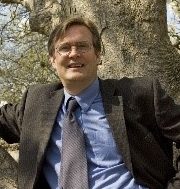 Timothy Beatley is the Teresa Heinz Professor of Sustainable Communities, in the Department of Urban and Environmental Planning, School of Architecture at the University of Virginia, where he has taught for the last twenty-five years. Much of Beatley’s work focuses on the subject of sustainable communities, and creative strategies by which cities and towns can fundamentally reduce their ecological footprints, while at the same time becoming more livable and equitable places. He believes that sustainable and resilient cities represent our best hope for addressing today’s environmental challenges. Beatley received his PhD from the University of North Carolina.
Timothy Beatley is the Teresa Heinz Professor of Sustainable Communities, in the Department of Urban and Environmental Planning, School of Architecture at the University of Virginia, where he has taught for the last twenty-five years. Much of Beatley’s work focuses on the subject of sustainable communities, and creative strategies by which cities and towns can fundamentally reduce their ecological footprints, while at the same time becoming more livable and equitable places. He believes that sustainable and resilient cities represent our best hope for addressing today’s environmental challenges. Beatley received his PhD from the University of North Carolina.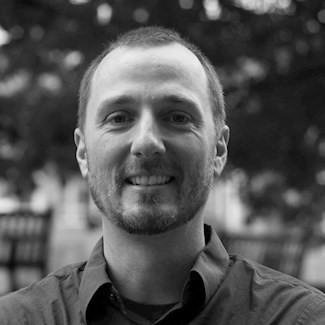 JD Brown is the Program Director of Biophilic Cities. In this role he expands and deepens connections between the partner cities of the Biophilic Cities Network and the many individuals and organizations advancing the theory and practice of planning and designing biophilic cities. With a law degree from the Georgetown University Law Center and a Masters in Urban and Environmental Planning from the University of Virginia, JD explores the intersection of law and planning through a survey of legal and policy mechanisms adopted by cities to promote abundant and accessible nature. Through this research, JD seeks to introduce successful, innovative biophilic codes to a global audience and to distill best practices that make these tools work for cities around the world.
JD Brown is the Program Director of Biophilic Cities. In this role he expands and deepens connections between the partner cities of the Biophilic Cities Network and the many individuals and organizations advancing the theory and practice of planning and designing biophilic cities. With a law degree from the Georgetown University Law Center and a Masters in Urban and Environmental Planning from the University of Virginia, JD explores the intersection of law and planning through a survey of legal and policy mechanisms adopted by cities to promote abundant and accessible nature. Through this research, JD seeks to introduce successful, innovative biophilic codes to a global audience and to distill best practices that make these tools work for cities around the world.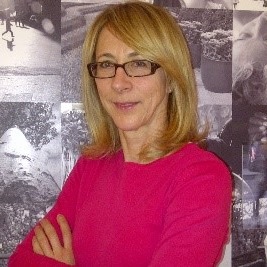 Jane Weninger is a Senior Planner with the City of Toronto where she is responsible for green space system planning. Working at the intersection of urban planning and the natural environment in Canada's largest city, Jane helps develop and implement city-wide strategies including Toronto's first Biodiversity Strategy and the Toronto Ravine Strategy. She provides strategic policy direction and analysis in response to provincial and local initiatives including the Greenbelt, watershed plans, park development and large development initiatives. Jane led the City's involvement in the establishment of Canada's first National Urban Park and expanded protection for environmentally significant areas across the city. Jane collaborated with a visual artist to produce An Enduring Wilderness a book and photography exhibition about Toronto's natural parklands commissioned by the City of Toronto. Jane believes that natural landscapes and biodiversity are fundamental to the quality of urban life. Jane sits on the Board of Directors of a not for public profit art gallery in Toronto. Jane holds a MSC from the University of Toronto and a BA from the University of British Columbia.
Jane Weninger is a Senior Planner with the City of Toronto where she is responsible for green space system planning. Working at the intersection of urban planning and the natural environment in Canada's largest city, Jane helps develop and implement city-wide strategies including Toronto's first Biodiversity Strategy and the Toronto Ravine Strategy. She provides strategic policy direction and analysis in response to provincial and local initiatives including the Greenbelt, watershed plans, park development and large development initiatives. Jane led the City's involvement in the establishment of Canada's first National Urban Park and expanded protection for environmentally significant areas across the city. Jane collaborated with a visual artist to produce An Enduring Wilderness a book and photography exhibition about Toronto's natural parklands commissioned by the City of Toronto. Jane believes that natural landscapes and biodiversity are fundamental to the quality of urban life. Jane sits on the Board of Directors of a not for public profit art gallery in Toronto. Jane holds a MSC from the University of Toronto and a BA from the University of British Columbia.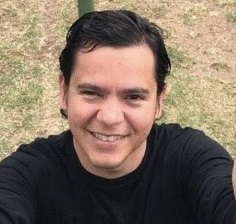 Huberth Méndez Hernández is an advisor to the Mayor of Curridabat, Costa Rica. He is an architect of many disciplinary territories, with broad expertise in linking the build and the natural environment, promoting biodiversity as key tool for holistic wellbeing, traveling a meaningful path leading advocacy efforts in sustainable urban movements, coordinating environmental committees and running government institutions, with experience in nature based solutions, sustainable building design, environmental research, multilevel fundraising, urban mobility, restorative land management and institutional management.
Huberth Méndez Hernández is an advisor to the Mayor of Curridabat, Costa Rica. He is an architect of many disciplinary territories, with broad expertise in linking the build and the natural environment, promoting biodiversity as key tool for holistic wellbeing, traveling a meaningful path leading advocacy efforts in sustainable urban movements, coordinating environmental committees and running government institutions, with experience in nature based solutions, sustainable building design, environmental research, multilevel fundraising, urban mobility, restorative land management and institutional management.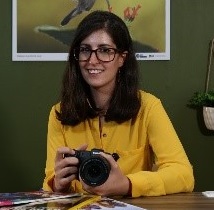 Tamara Blazquez Haik is Mexican Conservation Photographer who studied at the Club Fotográfico de México and Escuela Activa de Fotografía. She is a winner of various global awards and a member of IUCN’s Commission on Education and Communication. She has worked as a speaker and environmental educator in different parts of Mexico and internationally, teaching about the importance of urban biodiversity conservation and Mexico’s birdlife through photography. In 2017 she was a speaker in TEDxPolanco in Mexico City on the importance of photography for nature’s conservation. Her work has been published by National Geographic and other media in Mexico and around the world. She is presently working on the photographic and educational series “Fauna de la Ciudad de México” (Mexico City’s wildlife), a project aimed at teaching citizens, especially children, about the urban wildlife in Mexico City and how to protect them and their ecosystems. This is done through photo exhibits and school workshops.
Tamara Blazquez Haik is Mexican Conservation Photographer who studied at the Club Fotográfico de México and Escuela Activa de Fotografía. She is a winner of various global awards and a member of IUCN’s Commission on Education and Communication. She has worked as a speaker and environmental educator in different parts of Mexico and internationally, teaching about the importance of urban biodiversity conservation and Mexico’s birdlife through photography. In 2017 she was a speaker in TEDxPolanco in Mexico City on the importance of photography for nature’s conservation. Her work has been published by National Geographic and other media in Mexico and around the world. She is presently working on the photographic and educational series “Fauna de la Ciudad de México” (Mexico City’s wildlife), a project aimed at teaching citizens, especially children, about the urban wildlife in Mexico City and how to protect them and their ecosystems. This is done through photo exhibits and school workshops.








